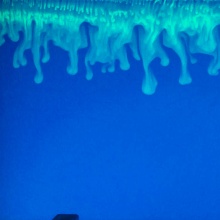The hypothesis
The working group nerochytic speleogenesis (short: AK NERO) is dedicating research efforts to a hypothesis which we believe is highly relevant for the understanding of karstification. The core of the hypothesis is that CO2 in karst is not only in a passive transport with the flowing water (Bögli, Dreybrodt, Klimtschuk), but it has in addition to that a mobility and dynamics of its own (thus NERO from greek nerochytis/sink). This inherent mobility in vertical direction is coupled to the cave ventilation in summer times in the vadose zone. At the karst water interface, the CO2 dissolves enhanced by convection which is induced by an increased density of the water.
This karst water, “inoculated” with additional CO2, contributes to new subsurface flow paths with their typical round-shaped, phreatic shapes at cave walls as they can be found in many fossile caves.
The location
The Swabian Alb belongs to the so-called green karst. A soil layer produces CO2, the vadose zone is up to 200 m thick. More than 2.500 caves are known. A number of karstic springs have their sources in in caves at the edges of this low mountain range. The karstification is still ongoing. The underground is mainly massive compact limestone. The history of rivers and landscape allows rough estimates on the history of karstification.
How the thesis came up
Exploring caves and the experience of visiting caves is popular since the late 18th century. The members of cave clubs and associations were citizens with interests in caves and speleogenesis, but also archaeology, geology, or hydrology.
The discovery of huge cave halls by Jochen Hasenmayer in the Blautopf underwater cave in 1985 has revealed a presumed or real contradiction between karstification processes and the ages of caves. This discussion amongst scientists and citizens is since then followed by an interested public. Arguments are exchanged, observations are shared or rejected.
The aspect NERO with mobile CO2 originated from a flash of inspiration during a discussion among cavers in October 2013.
Cooperation partner
Related projects
Literature
- Class, H., Bürkle, P., Sauerborn, T., Trötschler, O., Strauch, B., & Zimmer, M. (2021). On the role of density‐driven dissolution of CO 2 in phreatic karst systems. In Water Resources Research. American Geophysical Union (AGU). https://doi.org/10.1029/2021wr030912
- Class H.; Weishaupt K.; Trötschler, O.: Experimental and simulation study on validating a numerical model for CO2 density-driven dissolution in water, Water 2020, 12, 738.
https://doi.org/10.3390/w12030738 - Scherzer, H.; Class, H.; Bürkle, P.: Nerochytische Speläogenese - Versenkung von CO2 aus der vadosen Zone in das Kastwasser der phreatischen Zone: Stand der Forschung 2020. Laichinger Höhlenfreund 2020, 55, 3-20.
Further information about this publication. - Scherzer, H.; Class, H.; Weishaupt, K.; Sauerborn, T.; Trötschler, O.: Nerochytische Speläogenese: Konvektiver Vertikaltransport von gelöstem CO2 —Ein Antrieb für Verkarstung in der phreatischen Zone im Bedeckten Karst. Laichinger Höhlenfreund 2017, 52, 29–35.
- Class, H., Keim, L., Schirmer, L., Strauch, B., Wendel, K., & Zimmer, M. (2023).
Seasonal dynamics of gaseous CO2 concentrations in a karst cave correspond with aqueos concentrations in a stagnant water column, Geosciences 2023, 13 (2), 51.
https://doi.org/10.3390/geosciences13020051
as well as a number of student theses supervised by Holger Class, Joachim Gross, Rolf Stierle, Oliver Trötschler and Kilian Weishaupt.
Contributions to conferences and workshops
- Class H.; Weishaupt K.; Trötschler O.; Scherzer H.: Density-induced CO2 dissolution – approaches to test a new hypothesis on a process relevant for epigenetic karstification, EGU General Assembly 2020, 4-8 May 2020.
- Scherzer H.; Class H.: Nerochytische Speläogenese, Übergang von CO2 aus Höhlenluft (vadose Zone) in Karstwasser (phreatische Zone). Stand der Forschung 2019, 10. Symposium Verkarstung in Süddeutschland, 23. November 2019, Laichingen.
- Scherzer H.; Class H.: Mobilität von CO2 in der phreatischen Zone des bedeckten Karstes – eine Abschätzung zur Bedeutung für die Höhlenentstehung. Inspiriert aus Beobachtungen in Höhlen der Schwäbischen Alb. Tagung des Verbands der deutschen Höhlen- und Karstforscher (VDHK), 15.-18. Juni 2017, Laichingen.
- Scherzer, H., Class, H., Strauch, B., Zimmer, L., Länge, A.: Nerochytic speleogenesis, mobile CO2 as a drive for karstification, 18th International Congress of Speleology, UIS 2022, 24.-31. July, Savoie/France
Press Reports
Contact

Holger Class
apl. Prof. Dr.-Ing.Akademischer Oberrat, Deputy Head of the Department


